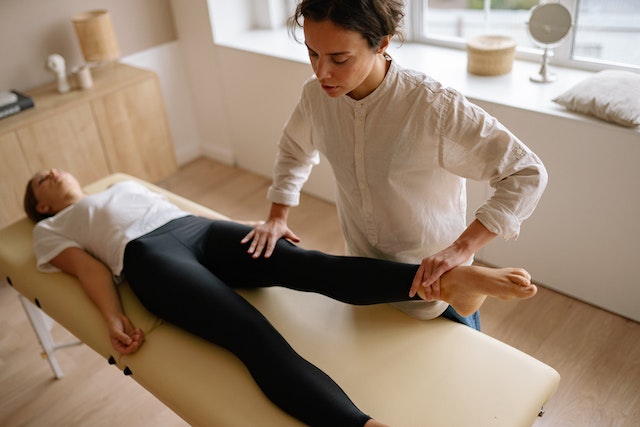Have you experienced repetitive pain radiating from your lower back to your knees or foot?
It may be sciatica, a painful condition that occurs due to inflammation and compression of the sciatic nerve root. [1]
Sciatica pain is extremely disabling and hampers most of your routine activities putting you under tremendous psychological stress.
But did you know that psychological stress worsens sciatica pain by releasing inflammatory chemicals in the body?
Stress and sciatica pain thus enter a vicious cycle.
Research shows that managing mental stress thus becomes as important as pain management in sciatica. [2]
And…
If you would like to learn why my clients describe this unique back rehab transformation methodology as the most successful, predictable back health transformation programme in the UK here are just a few back pain transformation case studies like Hayley, Franco, Elizabeth Tiffany, Jan, Michaela, W.T. Police officer, Emma, Huw or Dr Christian NHS.
So let me explain to you that it is easy to manage sciatica pain with customised sciatica rehab exercises, Pilates and selected Yoga.
The Relationship Between Stress and Sciatica Pain
Having a healthy and stress-free mind is as important as a healthy body.
As Debbie Hampton has quoted,
“Take care of your mind, and your body will thank you.”
Your emotions and stress levels have a lot to do with your physical status.
I will explain here now some of the physical effects of stress on the body.
- What exactly is stress and what are the physical effects of stress on the body?
Your brain is the origin of stress under threatening situations.
One important response to stress is the release of inflammatory mediators that give rise to ailments such as sciatica pain.
So your mind and body have a connection!
Researchers refer to stress as a condition of the mind-body connection. [3]
- Stress a trigger of sciatica pain:
There is a two-way communication between your brain and body.
Mental stress occurs as stress-causing chemicals are released from your brain and research shows that in turn this trigger inflammatory mediators that cause more nerve pain, stiffness and body aches. [3,4]
- The mind-body nexus:
Research shows that stress is one of the contributing factors to inflammation that results in sciatica pain.
Several studies have clinically proven how mental stress is a trigger for sciatica pain and lower back pain in general. [5-7]
Hence, I strongly suggest that the mind-body connection must be a primary target in sciatica pain management.
Are you ready to get rid of stress, predictably rehab your sciatica and achieve your sciatica pain relief goals?
BOOK YOUR FREE CONSULTATION NOW!The Importance of Managing Stress for Sciatica Pain Relief
What could be a better approach than relieving psychological stress levels to prevent, cope, adapt and manage your sciatica pain?
Here are the tips:
- Relax and reduce pain:
The role of stress management in preventing sciatica pain is based on the mind-body connection.
Research shows that mind-body therapies, breathing techniques and relaxation will relax the mind and relieve stress, and ultimately prevent pain.[8]
- Destress to relieve pain:
Are you in a stressed-out mode due to unbearable sciatica pain?
 I am here as you on board the destressing journey through the following techniques for managing stress and relieving sciatica pain.
I am here as you on board the destressing journey through the following techniques for managing stress and relieving sciatica pain.
- Assessment based customised Pilates rehab exercises
- Selected physical exercises (asanas and postures in yoga).
- Meditative asanas from Yoga to get a calm and relaxed stress-free mind.
- Stress busters such as Yog-nidra where you enter a sleep phase to relax the mind
- Your stress relievers:
Research shows that the following examples of stress management techniques can help with sciatica pain:
- Performing customised yoga postures for neurodynamic mobilisation. [9]
- Practising meditation for stress relief.
- Mastering breathing techniques for relaxation.
- Cognitive behavioural therapy for coping with pain. [10]
Stress Management Techniques for Sciatica Pain Relief
Self-awareness, self-care and relaxation techniques are the foundation of managing stress levels.
A holistic approach is all you need.
I will discuss some techniques here:
- Keep moving the right way: Sciatica pain makes normal movements challenging.
Hence when doctors recommend physical activity, you need an experienced and trained person who will get the correct exercises and physical activity done.
 Here are a few structured exercises for you:[11]
Here are a few structured exercises for you:[11]
- Static and dynamic lumbar stabilising exercises
- Motor control exercises
- Muscle strengthening exercises
- Directional preference exercises
- The power of breathing: Deep breathing exercises are a powerful mind-body technique that relaxes your mind and relieves psychological stress.
It helps control the heart rate that typical rises due to stress and anxiety.
Scientific evidence supports the positive effects of deep breathing on health.[12]
- Relax to let out stress: The mind-body connection helps in achieving great results as you practice progressive muscle relaxation.
Under my guidance, and of course based on your assessment as a team we can start creating the expected results in managing and eliminate your sciatica pain through these approaches (but not limited to).[13]
- Holistic Healing: Yoga is a holistic healing approach that targets the mind-body connection.
Researchers have already included Yoga as an integrated therapy in NHS, UK. [14]
Clinical studies indicate the following benefits of customised yoga:[15]
- Increase mobility
- Strengthen the spine
- Relax the muscles
- Relieve stiffness
- Relax your mind during sciatica pain treatment. [9,15]
Tips for Finding the Right Personal Trainer for Sciatica Pain Relief
All you need is the right sciatica rehab personal trainer to guide you for sciatica pain relief. Here are tips to find one:
- Check the credentials and experience of the trainer, for the correct guidance.
- Explore the expertise and specialisation in working with clients with sciatica pain.
- Good communication skills and rapport with clients will be important assets during therapy.
- Choose one that has easy availability and scheduling flexibility.
- Also, check the cost and payment options and be ready to commit financially to successfully help you achieve your rehabilitation goals.
 Sciatica pain traverses a large area in your lower body parts affecting your quality of life.
Sciatica pain traverses a large area in your lower body parts affecting your quality of life.
If your mind is relaxed and stress-free, pain management becomes much easier.
You need a Clinical Exercises Specialist who can customise all your yoga postures, physical activity, deep breathing and meditation techniques and help in reducing stress.
Why the customised approach is always successful?
Consider two friends having the same working habits but having different intensities of sciatica pain.
Can they have similar treatment?
No!
One size doesn’t fit all.
It has to be tailor-made for every person depending upon the cause of pain, severity of pain, physical ability, muscle strength, and overall fitness.
Jazz has expertise in customised exercise sets and with his holistic approach, he can help you practice techniques that target your mental stress to relieve your physical pain.
Are you keen to get started?
Contact Jazz now for your free consultation!
Who is Jazz Alessi?
Jazz is London’s best Sciatica Pain Exercise Rehab Specialist and Elite Personal Trainer.
As you can read though his clients rehabilitation he has long-term expertise in spine pain management, herniated disc, bulging discs, spine regeneration, healthy spine reconstruction through customised exercise and assessment based sciatica pain rehab.
Trust me, Jazz’s methods of practice reach the roots to relieve you from pain.
Carefully planned and customised rehabilitation exercises and a holistic approach with his deep knowledge of Pilates and Mais’s Yoga, you will be professionally helped to manage a nasty condition like sciatica pain.
FAQs
1. What is the most common cause of sciatica pain?
Nerve inflammation, spine degeneration and compression of the nerve due to bulged disc in vertebrae causes sciatica pain.
2. Can stress cause sciatica pain?
Yes. Stress may release inflammatory chemicals that definitely aggravates your back pain and in some instances might even cause sciatica pain.
3. How does stress management help relieve sciatica pain?
Stress management relaxes the mind and therefore, it helps you control inflammation to relieve sciatica pain.
4. What are some effective stress management techniques for sciatica pain relief?
Customised Pilates and Yoga, selected sciatica rehab exercises, meditation, deep breathing, and progressive muscle relaxation can help you relieve your sciatica pain.
5. Is it safe to exercise with sciatica pain?
Yes, you can exercise safe under the guidance of an experienced sciatica rehab trainer since you must ensure that you will not cause a disc re-injury, aggravate your sciatica pain and in a predictable manner you will successfully solve it.
6. How long does it take to recover from sciatica pain?
Your sciatica pain assessment will show how long your recovery will take. As a general rule it might take from 3 to 6 weeks to 3-4 months of regular and consistent exercise rehab to help you recover from sciatica pain and maintain the goals in the long run.
7. What are the benefits of personal training for managing sciatica pain?
Rehab personal training is a very comprehensive assessment-based approach therefore, it will help you use only the effective required and safe exercises and techniques so you will achieve successful pain management in sciatica rehab.
References:
1. Valat, J.-P.; Genevay, S.; Marty, M.; Rozenberg, S.; Koes, B. Sciatica. Best practice & research Clinical rheumatology 2010, 24, 241-252, doi:https://www.sciencedirect.com/science/article/abs/pii/S1521694209001417.
2. Singh, A.K.; Singh, O.P. A preliminary clinical evaluation of external snehan and asanas in the patients of sciatica. International Journal of Yoga 2013, 6, 71, doi:https://www.ncbi.nlm.nih.gov/pmc/articles/PMC3573547/.
3. McEwen, B.S. Protective and damaging effects of stress mediators: central role of the brain. Dialogues in clinical neuroscience 2022, doi:https://www.tandfonline.com/doi/full/10.31887/DCNS.2006.8.4/bmcewen.
4. Verwoerd, A.J.H.; Luijsterburg, P.A.J.; Lin, C.W.C.; Jacobs, W.C.H.; Koes, B.W.; Verhagen, A.P. Systematic review of prognostic factors predicting outcome in non-surgically treated patients with sciatica. European Journal of Pain 2013, 17, 1126-1137, doi:https://doi.org/10.1002/j.1532-2149.2013.00301.x.
5. Cook, C.E.; Taylor, J.; Wright, A.; Milosavljevic, S.; Goode, A.; Whitford, M. Risk factors for first time incidence sciatica: a systematic review. Physiotherapy Research International 2014, 19, 65-78, doi:https://onlinelibrary.wiley.com/doi/abs/10.1002/pri.1572.
6. Hurwitz, E.L.; Morgenstern, H.; Yu, F. Cross-sectional and longitudinal associations of low-back pain and related disability with psychological distress among patients enrolled in the UCLA Low-Back Pain Study. Journal of clinical epidemiology 2003, 56, 463-471, doi:https://www.sciencedirect.com/science/article/abs/pii/S0895435603000106.
7. Parreira, P.; Maher, C.G.; Steffens, D.; Hancock, M.J.; Ferreira, M.L. Risk factors for low back pain and sciatica: an umbrella review. The spine journal 2018, 18, 1715-1721, doi:https://www.sciencedirect.com/science/article/abs/pii/S1529943018302432.
8. Erwin Wells, R.; Phillips, R.S.; McCarthy, E.P. Patterns of mind-body therapies in adults with common neurological conditions. Neuroepidemiology 2011, 36, 46-51, doi:https://pubmed.ncbi.nlm.nih.gov/21196772/.
9. Sharma, T.; Singh, S. Development of an integrated Yoga module for Low Back Pain (LBP) in adults through research reviews. 2023, doi:https://www.theyogicjournal.com/pdf/2023/vol8issue1/PartA/7-2-42-605.pdf.
10. Petrucci, G.; Papalia, G.F.; Russo, F.; Vadalà, G.; Piredda, M.; De Marinis, M.G.; Papalia, R.; Denaro, V. Psychological approaches for the integrative care of chronic low back pain: a systematic review and metanalysis. International Journal of Environmental Research and Public Health 2021, 19, 60, doi:https://pubmed.ncbi.nlm.nih.gov/35010319/.
11. Ostelo, R.W. Physiotherapy management of sciatica. Journal of physiotherapy 2020, 66, 83-88, doi:https://www.sciencedirect.com/science/article/pii/S1836955320300229.
12. Perciavalle, V.; Blandini, M.; Fecarotta, P.; Buscemi, A.; Di Corrado, D.; Bertolo, L.; Fichera, F.; Coco, M. The role of deep breathing on stress. Neurological sciences : official journal of the Italian Neurological Society and of the Italian Society of Clinical Neurophysiology 2017, 38, 451-458, doi:https://link.springer.com/article/10.1007/s10072-016-2790-8.
13. Toussaint, L.; Nguyen, Q.A.; Roettger, C.; Dixon, K.; Offenbächer, M.; Kohls, N.; Hirsch, J.; Sirois, F. Effectiveness of progressive muscle relaxation, deep breathing, and guided imagery in promoting psychological and physiological states of relaxation. Evidence-Based Complementary and Alternative Medicine 2021, 2021, doi:https://www.ncbi.nlm.nih.gov/pmc/articles/PMC8272667/.
14. Mason, H.; Schnackenberg, N.; Monro, R. Yoga and healthcare in the United Kingdom. International journal of yoga therapy 2017, 27, 121-126, doi:https://pubmed.ncbi.nlm.nih.gov/29131732/.
15. Monro, R.; Bhardwaj, A.K.; Gupta, R.K.; Telles, S.; Allen, B.; Little, P. Disc extrusions and bulges in nonspecific low back pain and sciatica: Exploratory randomised controlled trial comparing yoga therapy and normal medical treatment. Journal of Back and Musculoskeletal Rehabilitation 2015, 28, 383-392, doi:https://pubmed.ncbi.nlm.nih.gov/25271201/.



